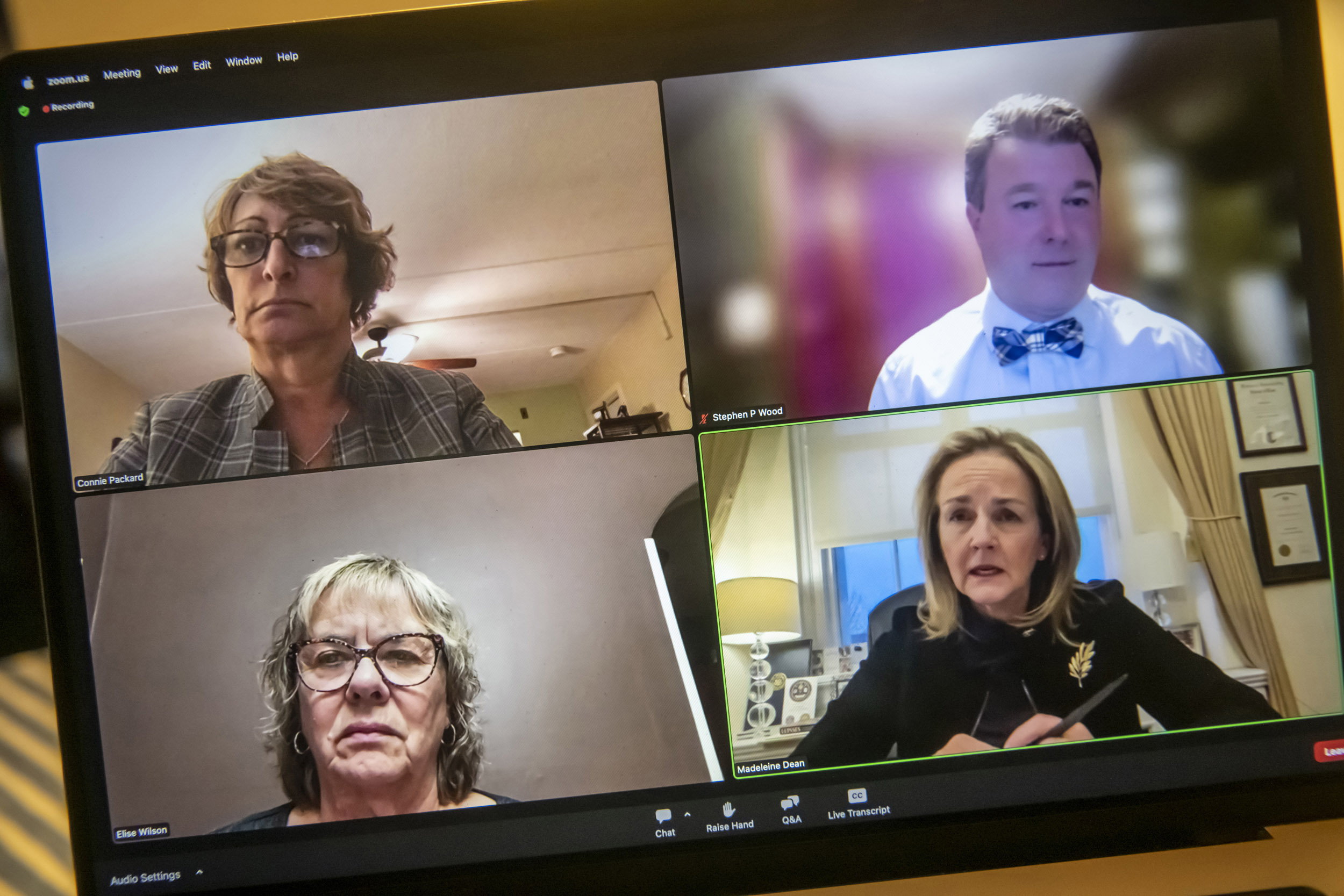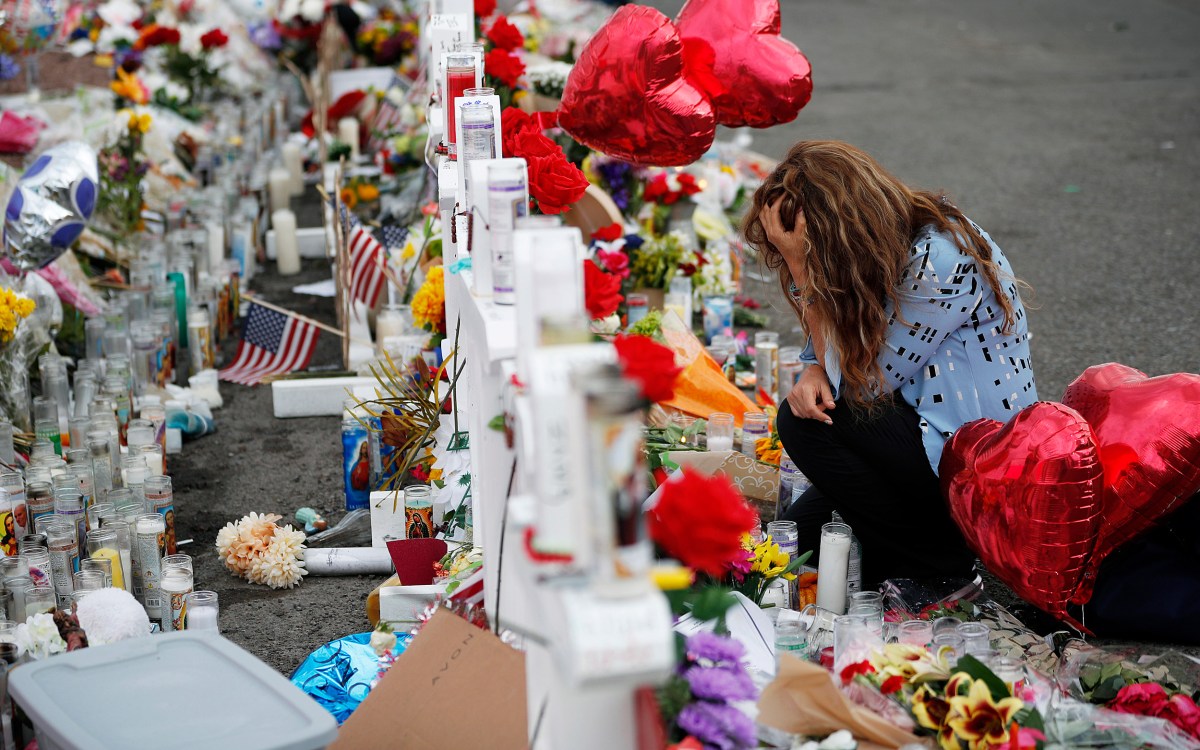
Panelists included Connie Packard, president of International Association for Healthcare Security and Safety (clockwise from top left); Stephen Wood, nurse practitioner; U.S. Rep. Madeleine Dean; and Elise Wilson, registered nurse.
Jon Chase/Harvard Staff Photographer
Halting rising violence against health care workers
Law School discussion weighs effectiveness of legislation, technology, policies
Elise Wilson felt pretty confident in her ability to spot red flags, having worked as an emergency room nurse at Harrington Hospital in Southbridge, Massachusetts, for nearly two decades. And she had really only turned her back for a second on the patient, who would later be diagnosed with mental illness, before he began stabbing her in the neck and arm.
“He was standing literally right in front of me. I had nowhere to go,” Wilson said. “And the first thing he did was punch me in the head. And when I turned back, he was standing basically knee to knee with me and he had a knife in his hand over his head.”
Wilson recounted the 2017 attack at a virtual discussion Tuesday night on the need to prevent rising violence against health care workers. Other panelists at the event, hosted by Harvard Law School’s Petrie-Flom Center for Health Law Policy, Biotechnology, and Bioethics, included a member of Congress who has introduced legislation on the issue and three other health care professionals.
Participants made clear the problem is serious and growing more severe. According to the 2018 U.S. Bureau of Labor Statistics, health care workers accounted for 73 percent of all nonfatal workplace violence-related injuries and illnesses. And more than eight in 10 health care workers reported in a National Nurses United survey that they had experienced at least one type of workplace violence during the pandemic, when the need for care grew amid nationwide staff shortages.
“We know that health care workers are facing threats, intimidation, and in some horrific circumstances, actual violence, and we know that it is happening more and more,” said Democratic Rep. Madeleine Dean of Pennsylvania.
Dean joined with Republican Rep. Larry Bucshon, an Indiana physician, to introduce a bill this past summer to provide legal protection for hospital employees assaulted on the job by making such acts of violence a federal crime.
“If we can deter this behavior from patients, their families, or others, and we can ensure that health care workers have the knowledge and best practices, the ability to protect themselves, we will be really happy to have been a very small part of solving this problem,” she said.
More than eight in 10 health care workers reported in a National Nurses United survey that they had experienced workplace violence during the pandemic.
The measure, called the Safety from Violence for Healthcare Employees (SAVE) Act, is modeled on legislation that protects airline workers from violence by instituting stricter penalties for perpetrators. It also aims to improve training and prevention strategies through a $25 million grant for hospitals nationwide. It currently has more than 50 co-signers and has been endorsed by several health care advocacy organizations, including the American Hospital Association and Federation of American Hospitals.
“It’s all about being prepared and mitigating risks,” said Connie Packard, a longtime law enforcement officer and president-elect of the International Association for Healthcare Security and Safety.
Packard, who is currently the chief of public safety at Boston Medical Center, laid out strategies in conjunction with legislation that aims to help keep health care workers safe. She spoke to the need for hospitals to assess their workplace violence-prevention policies, review technology such as personal panic alarms and metal screening, and network with other agencies working on hospital security.
Wilson said the attack left her with permanent nerve damage and ongoing mobility issues that have prevented her from returning to work as a nurse, but expressed hope that her story may inspire action from lawmakers and hospital administration alike. “It has to stop,” she said.
Carmel Shachar, executive director of the Petrie-Flom Center, said that scholars at the Law School will continue to pay attention to how targets of violence in health care settings receive justice and legal protections, and that she hopes Tuesday’s panel helps further the conversation.
“We were really honored to host such a distinguished panel. And I think that it was especially meaningful that Elise shared her firsthand account of violence in the health care workplace, because it’s a very heavy story that can’t be easy to share. Those reflections, those first-person narratives, are so important to understand what the stakes are,” she said.








